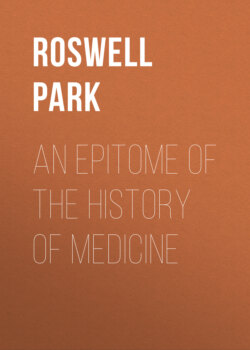Читать книгу An Epitome of the History of Medicine - Roswell Park - Страница 6
На сайте Литреса книга снята с продажи.
Original
ОглавлениеHaving solemnly thanked the god, he went away. There is reason to think that the priests of these temples made for their own uses much more minute and accurate accounts, which should be of some real service, since the writings which have come down to us evince a habit of close observation and clear description of disease. During the Trojan War two men are frequently mentioned by Homer as possessing great surgical skill. These were Machaon and Podalirius. They were regarded as sons of Æsculapius, the former being the elder. The first account of venesection, although not authentic, refers to the bleeding practiced by the latter upon the daughter of the King of Caria, upon whose shores Podalirius was cast by tempest after the ruin of Priam's kingdom. Whether he was the first of all men to practice it or not, it is certain that the act of venesection goes back long prior to the era of Hippocrates, who speaks of it as frequently performed.
Many of the deities upon Olympus seem at one time or another to have usurped medical functions. Apollo, the reputed father of Æsculapius, appropriated nearly everything under the name of Pæon, who assumed the privilege of exciting or subduing epidemics. Juno was supposed to preside at accouchements, and in both the Iliad and Odyssey it is indicated that Apollo was considered as the cause of all the natural deaths among men, and Diana of those among women.
The long Trojan War appears to have been an epoch-making event in the medical and surgical history of those times, as was the Civil War recently in our country. Certain vague and indefinite practices then took more fixed form, and from that time on medicine may be said to have been furnished with a history. After the dethronement of Priam and the destruction of his capital, navigation was free and unrestricted. The Hellenists covered with their colonies both shores of the Mediterranean, and their navigators even passed the pillars of Hercules. By these means the worship of Æsculapius passed from Greece into what is now Asia, Africa, and Italy. In his temple at Epidaurus was a statue of colossal size made of gold and ivory. The dialogues of Plato, especially the Phædo, make it apparent that the cock was the animal sacrificed to him, and hence sacred to the god of medicine. The priests attached to his worship were called Asclepiacloe, or descendants of Æsculapius. The temples were usually hygienically located near thermal springs or fountains and among groves. Pilgrimages were made from all quarters, and these localities became veritable health-resorts. A well-regulated dietary, pure air, temperate habits, and faith stimulated to a fanatical degree combined and sufficed for cures which even nowadays would be regarded as wonderful. The priests prescribed venesection, purgatives, emetics, friction, sea-baths, and mineral waters, as they appeared to be indicated. The imagination of the patient was continually stimulated, and at the same time controlled. Before interrogating the oracles they must be purified by abstinence, prayer, and sacrifice. Sometimes they were obliged to lie in the temple for one or more nights. The gods sometimes revealed themselves in mysterious ways, at times devouring the cakes upon the altars under the guise of a serpent, or again causing dreams which were to be interpreted by^the priests. There can be no doubt that sometimes, at least, the grossest frauds and the basest trickery were relied upon for the purpose of impressing the minds of those weakened by abstinence or influenced by drugs. Mercenary considerations were not lacking; moreover, cures were often not obtained until zeal had been redoubled by largely increased contributions to the treasury of the temples. In the neighborhood of many of these temples serpents abounded, non-venomous and easily tamed. These were employed by the priests in various supernatural performances by which the ignorant people were astonished and profoundly impressed. In fact, the serpent and the serpent-myth played a very large rôle in the early history of medicine as well as that of religion and religious symbolism.
It will thus be seen that during the space of about 700 years medicine underwent a transformation in Greece. It was first domestic and popular, practiced by shepherds, soldiers, and others; then became sacerdotal; after the Trojan War it was confined to the vicinity of the temples and practiced in the name of some divinity; and finally it was wrapped in mystery and mystic symbolism, where superstition was played upon and credulity made to pay its reward. Down to the time of Hippocrates the Asclep-iadæ rendered some genuine service to science, especially by inculcating habits of observation, in which Hippocrates excelled above all. Later, however, down to the time of the Christian era, medicine in the temples declined, and became, in fact, a system based upon the grossest jugglery.
It is time now that we make a systematic attempt to classify events in the history of medicine, and to recognize certain distinct epochs as they have occurred. For this purpose I know of no better arrangement than that of Renouard, which, in the main, I shall follow, at least during the forepart of this book. In this sense he divides the past into three ages, known, respectively, as the Age of Foundation, the Age of Transition, and the Age of Renovation. Each of these chronological divisions is subdivided into periods, of which the first contains four:—
